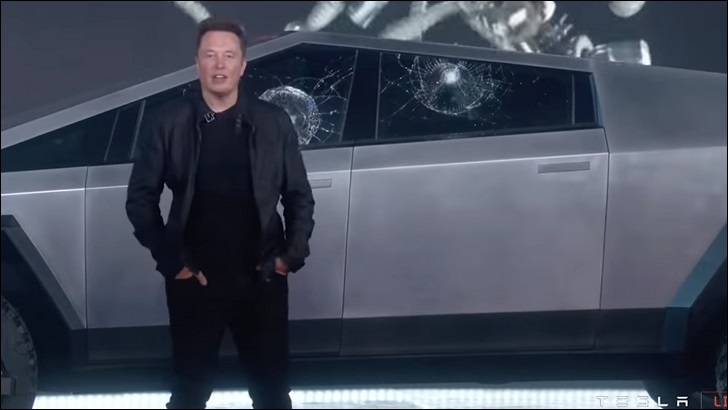Elon Musk fronted a welcoming crowd in California last week to unveil Tesla’s new car – the Cybertruck.
It’s an electric ute.
In a livestream event that bordered on shambolic, Elon Musk unveiled Tesla’s new product by fumbling through parts of his presentation and, at times, apparently unsure of what was meant to happen next.
Strobe lights, laser effects, and pyrotechnics welcomed the unusual-looking vehicle to stage with Musk exclaiming that it “doesn’t look like anything else”.
Straight lines and sharp edges mark a severe departure from the sleek looks of the Tesla Roadster Musk sent to space last year.
But unique aesthetics were overshadowed by the most memorable moment of the Cybertruck launch which came when Tesla designer, Franz Von Holzhausen, unintentionally shattered the ute’s windows with a metal ball during a bungled demonstration of the ute’s armour.
“Not bad,” Musk said after Von Holzhausen shattered a second window with the metal ball.
“Room for improvement.”

Prior to breaking the Cybertruck’s windows, Musk had been extolling the toughness of his new vehicle’s stainless-steel exoskeleton saying the steel alloy was the same used in SpaceX rockets and was “literally bulletproof to a 9mm handgun”.
But the failure of the ute’s “transparent metal” windows clearly surprised Musk who was left stuttering through the remainder of his presentation in front of two broken windows.
“We threw wrenches, we threw everything, we literally threw the kitchen sink at the glass and it didn’t break but for some weird reason it broke now,” Musk said.
“We’ll fix it in post.”
Musk later tweeted a video of Von Holzhausen successfully throwing a ball at the Cybertruck window prior to the launch event, saying hitting the door with a sledgehammer weakened the glass.
Franz throws steel ball at Cybertruck window right before launch. Guess we have some improvements to make before production haha. pic.twitter.com/eB0o4tlPoz
— Elon Musk (@elonmusk) November 23, 2019
Tesla fans not deterred
The Cybertruck has three models from $59,000 (US$39,900) to $103,000 (US$69,900): a single motor rear wheel drive, dual motor all-wheel drive, and tri motor all-wheel drive.
Base models have a range of 400km, a towing capacity of nearly 3,500kg, and a storage bed comparable to common utes. Tesla Autopilot comes standard on all Cybertrucks, but there is an option for “full self-driving” if you want to fork out another US$7,000.
Tesla showed videos of the ute out-sprinting a Porsche 911, and dragging along a Ford F150 – but it did not mention how such high-performance activities affected battery life and range.
A few busted panes of glass were not enough to deter would-be buyers who fronted up $100 to pre-order the Cybertruck that won’t even go into production until 2021.
More than 200,000 people pre-ordered a Cybertruck in the first four days after being launched, but they will still have to wait a while to get their hands on the electric ute as Tesla is still working through the growing backlog of orders for its current range of cars.
Tesla’s rate of production worried investors earlier this year after an analyst said Tesla’s forecast for delivering between 360,000 and 400,000 cars this year was “a Herculean task”.
In the first three quarters of this year, Tesla produced 260,000 vehicles meaning a minor increase in production would see it hit the low-end target.
Investors were once again put-off by Tesla with stock dropping from US$354 to a low of US$330 the day after Cybertruck was launched.










